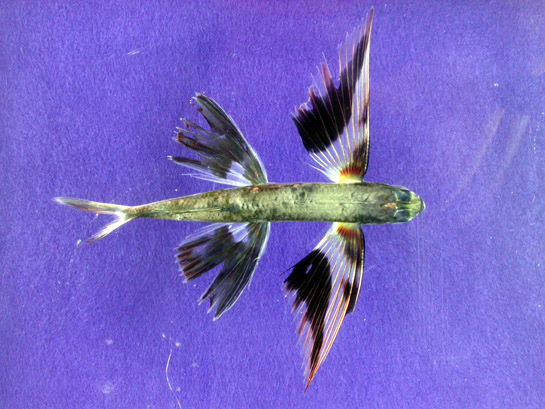Flying Fish (Family: Exocoetidae) - Wiki Flying fish
From Wikipedia, the free encyclopedia
[Photo] The Band-wing flyingfish, Cheilopogon exsiliens. Source: http://oceanexplorer.noaa.gov/explorations/03edge/logs/aug25/media/bandwing.html
Flying fish are a marine fish family comprising about 50 species grouped in 7 to 9 genera. Flying fish are found in all the major oceans, mainly in warm tropical and subtropical waters of the Atlantic, Pacific, and Indian oceans. Their most striking feature is their pectoral fins, which are unusually large, and enable the fish to take short gliding flights through air, above the surface of the water, in order to escape predators.
Appearance
Some flying fish shed their pectoral fins every 20 to 40 days. In some species the pelvic fins are also unusually large, so the fish appears to have four wings. Most species reach a maximum length of 30 cm, though a few may be as long as 45 cm. Their eyes are relatively larger than those of other fish as well as flatter which improves visual acuity in the air. Flying fish live close to the water surface and feed on plankton.
Flight
To prepare for a glide, the fish swim rapidly close to the surface of the water, with their fins close to the body. As they leave the water, they spread their fins. The caudal fin is usually deeply forked, with the lower lobe longer than the upper. The fish rapidly move the lower lobe to propel themselves forward once the rest of the body has already left the water. Eventually, even the tail leaves the water and the fish are airborne. They do not flap their "wings". In gliding, flying fish can almost double their speed, reaching speeds up to 60 km/h. The glides are usually up to 30-50 metres in length, but some have been observed soaring for hundreds of metres using the updraft on the leading edges of waves. The fish can also make a series of glides, each time dipping the tail into the water to produce forward thrust.
Flying fish use their unusual flying talent to escape predators such as swordfish, tuna, and other larger fish.
Importance
Flying fish, often preserved by drying, are a staple of the Tao people of Orchid Island. In Japanese cuisine, flying fish roe (Tobiko), often from Cheilopogon agoo (Japanese flying fish), is used to make some types of sushi.
Historically the country of Barbados was nicknamed as "The land of the Flying fish." The once abundant flying fish migrated between the warm coral-filled Atlantic Ocean surrounding the island of Barbados and the plankton-rich outflows of the Orinoco River in Venezuela. In Barbados, the flying fish is depicted on coins, as sculptures in fountains, in artwork, or even as part of the official logo of the Barbados Tourism Authority which features a Flying fish in flight. Additionally, the Barbadian coat of Arms features a Pelican and Dolphin on either side of the shield, but the dolphin resembles a flying fish.
Just after the completion of the Deep Water Habour in Bridgetown, Barbados saw an increase of international ships, linking the island to the world. As a result the overall health of the coral reefs surrounding Barbados suffered due to ship-based pollution. Additionally, over-fishing by Barbadians has meant the species of flying fish have slowly retreated closer to the Orinico River delta no longer returning around Barbados in large numbers. Today the flying fish only annually migrate as far north as the island of Tobago, around 120 nautical miles southwest of Barbados. Despite the move, Flying fish have remained a coveted delicacy in Barbados. In recent times the flying fish have also been gaining in culinary popularity in other islands, adding fuel to several Caribbean-maritime disputes.
In 2006 the council of the United Nations Convention on the Law of the Sea handed down a ruling fixing the maritime boundaries between Barbados and Trinidad and Tobago over the flying fish dispute which gradually raised inter-island tensions between the neighbours. The ruling stated that both countries must now preserve flying fish stock for the future. Barbadian fishers have still tried to follow the flying fish southward in search of the Barbadian delicacy. Flying fish remain an important part of Barbados' main national dish which is known as Cou Cou and Flying Fish.
Etymology
The term Exocoetidae comes from the Greek εξω-κοιτο?? (exo-koitos, "lying down outside" or "sleeping under the stars") and refers to the common occurrence of stranded flying fish lying in boats. The Exocet guided missile is presumably named after these fish. There are also three ships of the United States Navy named USS Flying Fish. The constellation Volans ("flying fish") also refers to this animal.
http://en.wikipedia.org/wiki/Flying_fish
| The text in this page is based on the copyrighted Wikipedia article shown in above URL. It is used under the GNU Free Documentation License. You may redistribute it, verbatim or modified, providing that you comply with the terms of the GFDL. |
